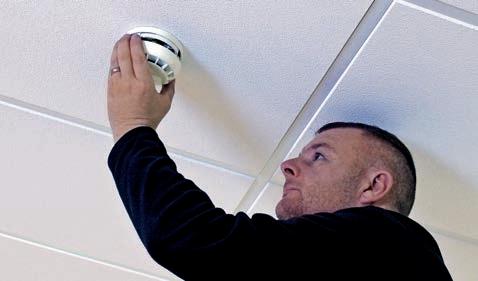SPECIAL FEATURE
FIRE, SAFETY & SECURITY
BS 5839-6:2019 — ARE YOU UP TO DATE? With revisions to the standard for domestic fire detection introduced last year, Neil Baldwin, managing director at ESP, takes a look at the key updates that contractors need to be aware of, to ensure that they are fully compliant when installing fire alarm systems.
T
The new grading system is as follows:
he BSI’s recent update of the domestic fire detection and alarm system standard, specifically Part 6 of BS 5839, outlines the code of practice for the design, installation, commissioning and maintenance of fire detection and fire alarm systems in domestic properties. The standard is aimed at architects, engineers and other building professionals, enforcing authorities, installers and others responsible for implementing fire precautions in domestic premises. It provides the latest recommendations for fire detection and fire alarm systems in both new and existing domestic premises, in order to make them safer to live in. The main revisions include: • Re-grading and revision of statistics and recommendations • Updating guidance to take all other standards in the BS 5839 series into account • New table on testing and servicing by grade of alarm system • New recommendations for ensuring alarm signal transmission required within social care and sheltered housing settings function accordingly • Increased protection in sheltered housing and supported housing • New recommendation that communal fire alarm systems should not normally be installed in purpose-built blocks of flats
The key standard The BS 5839 series of standards began life with the publication of BS 5839-1 in 1980. It has since grown into nine parts, splitting domestic and non-domestic premises and also dealing with a range of specific systems in detail. Part 6 has become the key standard for domestic premises. The document supplies guidance and recommendations on planning, designing, installing, commissioning and maintaining detection and fire alarm systems. The recommendations refer principally to fire detection and fire alarm systems installed for the purpose of life safety, but also include recommendations for systems that are intended to protect property. The standard covers homes designed to accommodate a single family; HMOs comprising a number of self-contained units, each designed to accommodate a single family; and sheltered housing, including both the dwelling units and the common areas. It applies to both new and
46 | November 2020
Fire, Safety & Security – ESP.indd 46
existing premises. Its recommendations can be applied to the fire detection components of combined domestic fire and intruder alarm systems, or fire and social alarm systems. The standard also includes recommendations for routine attention. The systems it covers range from those comprising a single self-contained smoke alarm to systems of the type described in BS 5839-1. New recommendations have been added for fire detection in supported housing in particular, whilst revised guidance on the installation of communal fire alarm systems in purpose-built blocks of flats has also been introduced. The Standard has also been updated to reflect the updates made to Part 1 in 2017, which addresses non-domestic premises, combined with any other updates made to other Standards since the last full revision. Below is an outline of the key changes to BS 5839-6 and the areas to be aware of to ensure residents are offered the highest standard of fire protection throughout all types of domestic properties. This applies to property managers, architects, building professionals, installers and enforcing authorities.
• Grade A Separate detectors, sounders and central control and indicating equipment with back-up power supply that conforms to British Standards BS EN 54. • Grade C Separate detectors and sounders that are mains powered with back-up power supply and central control equipment. • Grade D1 A system of one or more mains powered detectors, each with a tamper proof standby supply consisting of a battery or batteries. • Grade D2 A system of one or more mains-powered detectors, each with an integral standby supply consisting of a user replaceable battery or batteries. • Grade F1 A system of one or more batterypowered detectors powered by a tamper proof primary battery or batteries. • Grade F2 A system of one or more batterypowered detectors powered by a user replaceable primary battery or batteries. These grades need to be adhered to when designing, constructing and managing fire detection and fire alarm systems in domestic properties. Attention also needs to be given to the revisions made to Table 1 of the Standard, which outlines the minimum grade and category of system that should be installed to provide protection of life in typical premises. The updates have been made to reflect current living conditions. In conjunction with Table 1, a new table has also been created, which outlines the recommended testing and servicing by grade to prevent the blocking or delaying of fire alarm signals transmitted via social alarm systems in sheltered housing to an alarm receiving centre. ESP, espuk.com
Revised system grading Whilst BS 5839-6 has previously been split into six varying Grades, each outlining the level of protection appropriate for certain properties and their corresponding levels of risk, the new update has altered the six sections, removing Grade B and Grade E, whilst Grade D and Grade F have been split into Grade D1 / Grade D2 and Grade F1 / Grade F2 respectively. Grade C has been revised and its recommendations expanded.
electricalcontractingnews.com
@ElecConNews
/electricalcontractingnews
21/10/2020 09:30
















